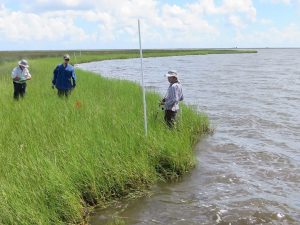Study Links Recovery of Oiled Marsh with Return of Salt Marsh Vegetation
– MARCH 22, 2016
Scientists studied the relationship between the resiliency of Louisiana salt marsh plants, invertebrates, and microbes in heavily-oiled sediment after the Deepwater Horizon spill.
The numbers and diversity of many small invertebrates associated with Spartina alterniflora roots had rebounded three years after the spill. This response indicates a strong link between recovery of Spartina and the food-web function of the broader marsh benthic community. They published their findings in Marine Ecology Progress Series: Recovery of salt marsh benthic microalgae and meiofauna following the Deepwater Horizon oil spill linked to recovery of Spartina alterniflora.
The study’s lead author, John Fleeger, explained that meiofauna are good indicators of marsh health, “These tiny invertebrates (smaller than 1 mm in length) live at the food web base, consume algae, and are food for juvenile fish and shellfish that use the marsh as a nursery ground. Plants improve the living conditions in the marsh soil, facilitating the recovery of small invertebrates that make the marsh so productive and fuel its food web.”
The team monitored marshes in Barataria Bay where Spartina dominate. Eleven months after marsh oiling, they observed a higher decline in benthic populations in areas where there was nearly total Spartina mortality. Microalgal biomass dropped more than 95% and total meiofauna densities decreased by 50 to 80% compared to collections from unoiled sites. However, Spartina and meiofauna recovery paralleled each other, with stem density and invertebrate species richness 1.5 times higher at moderately oiled sites compared to reference sites. Meiofauna density and diversity recovered more slowly where plants other than Spartina partially colonized areas that had almost complete vegetative mortality.
The researchers noted that some invertebrate species, especially larger benthic animals such as amphipods, have not fully recovered in heavily oiled marshes. Fleeger hopes that future studies will fill knowledge gaps by answering: “When is recovery complete for all the marsh plants and invertebrates? Do the largest invertebrates recover at the same rate as the smallest? What factors enhance or slow recovery for the various kinds of invertebrates? And, when does the marsh community begin to function as it did before the spill?”
The study’s authors are J. W. Fleeger, K. R. Carman, M. R. Riggio, I. A. Mendelssohn, Q. X. Lin, A. Hou, D. R. Deis, and S. Zengel.
************
This research was made possible by grants from the Gulf of Mexico Research Initiative (GoMRI) to Louisiana State University for two projects, Response of the Plant-Microbial-Benthic Ecosystem to Mitigation Strategies and Long-Term Effects on Plant-Soil-Benthic Systems, and to the Northern Gulf Institute.
The Gulf of Mexico Research Initiative (GoMRI) is a 10-year independent research program established to study the effect, and the potential associated impact, of hydrocarbon releases on the environment and public health, as well as to develop improved spill mitigation, oil detection, characterization and remediation technologies. An independent and academic 20-member Research Board makes the funding and research direction decisions to ensure the intellectual quality, effectiveness and academic independence of the GoMRI research. All research data, findings and publications will be made publicly available. The program was established through a $500 million financial commitment from BP. For more information, visit https://gulfresearchinitiative.org/.
© Copyright 2010- 2017 Gulf of Mexico Research Initiative (GoMRI) – All Rights Reserved. Redistribution is encouraged with acknowledgement to the Gulf of Mexico Research Initiative (GoMRI). Please credit images and/or videos as done in each article. Questions? Contact web-content editor Nilde “Maggie” Dannreuther, Northern Gulf Institute, Mississippi State University (maggied@ngi.msstate.edu).






